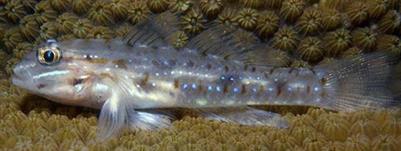



Coryphopterus spp
Notes:
Sand Gobies (Coryphopterus species) are very similar in appearance, with one species having fairly recently been split into 3 different species (hence some books and web resources are out of date on this issue), with small differences seen in external markings and some habitat differences, though the latter can overlap and are not rigidly set in stone. Links to individual pages
Bridled Goby: Coryphopterus glaucofraenum
Sand Canyon Goby: C. venezulae
Patch Reef Goby: C. tortugae
Colon Goby, C. dicrus
All can pale or darken dramatically according to background. Distinguishing markings may be hard to discern on very pale individuals.
Sand Gobies (Coryphopterus species) are very similar in appearance, with one species having fairly recently been split into 3 different species (hence some books and web resources are out of date on this issue), with small differences seen in external markings and some habitat differences, though the latter can overlap and are not rigidly set in stone. Links to individual pages
Bridled Goby: Coryphopterus glaucofraenum
Sand Canyon Goby: C. venezulae
Patch Reef Goby: C. tortugae
Colon Goby, C. dicrus
All can pale or darken dramatically according to background. Distinguishing markings may be hard to discern on very pale individuals.


| Common Name |
Pale spots behind eye | Nape markings | Markings at base of pectoral fin | Body markings |
Tail base markings |
Primary Habitat | |
| 1 | BRIDLED | Second spot elevated | Dark spots | None | Brown "X"s White Speckles |
2 dark spots - can be joined by thin line | <20ft Mangroves |
| 2 | SAND CANYON | Level row | Dark lines | 1 dark spot, can pale to yellowish | White Speckles | 2 dark spots - can be joined by thin line | Sand areas around reefs and rocks, usually 30-100ft, but common in shallows in Antigua |
| 3 | PATCH REEF not yet recorded |
Level row | Dark lines | None | White Speckles | 2 dark spots - can be joined by thin line | Sand areas around reefs and rocks, usually<30ft |
| 4 | COLON | None | Large brown spots | 2 dark to yellowish spots Occasionally 1, or none |
Brown speckles | None | Sand areas around reefs and rocks, usually 6-50ft, |
| 5 | PALLID | None | None | None | Orange/ Yellow broken stripes | Dark bar | Coral sand |
COMPARATIVE TABLE AND IMAGES

4. Patch Reef Goby
(not yet recorded in Antigua)
(not yet recorded in Antigua)




